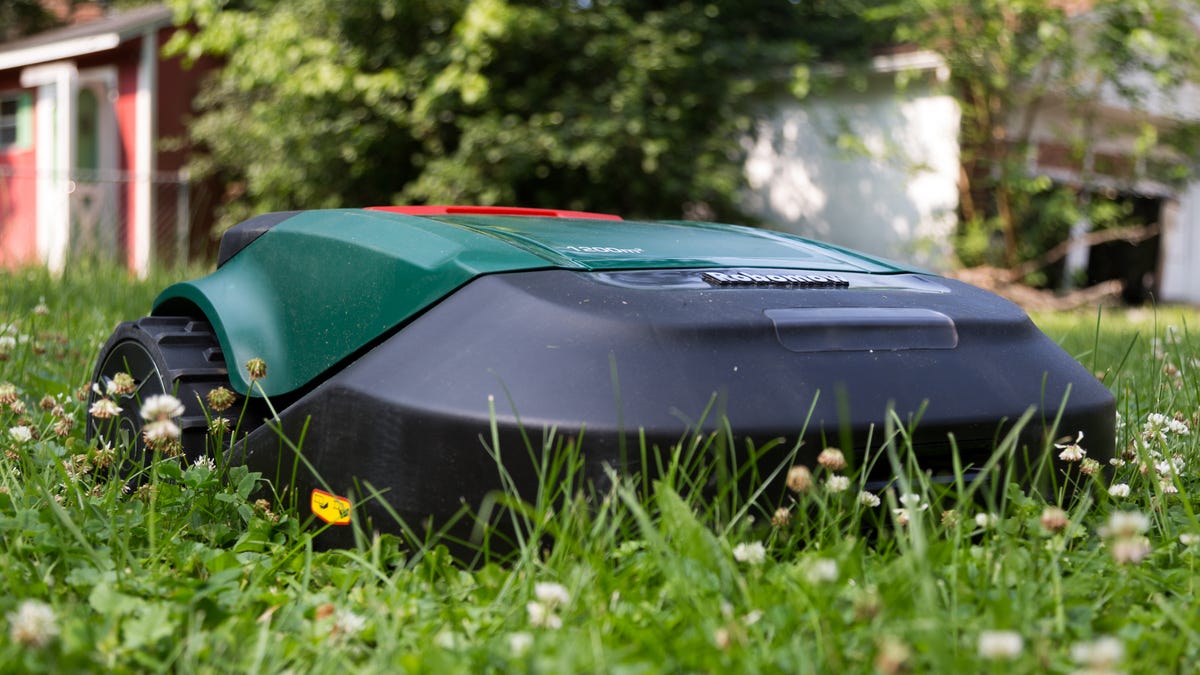The Robomow Diaries: Weather thwarts inaugural mow
We take a robotic lawnmower for its first cut through a CNET editor's front yard. But a rainy few days in Louisville, Ky., might have kept the Robomow from reaching its full grass-cutting potential.

(This is the first installment in a weekly series documenting our tests with the Robomow RS612.)
Thursday, July 7, 2016
We should've known better.
I've had the Robomow RS612 docked and charging at the edge of my front yard for two weeks. The length of the grass has just passed the embarrassing level and is heading into code violation territory. Sure, it's been raining off and on for five days in Louisville, KY., where CNET Appliances is based. But the rain had stopped when I woke up this morning, and I was on a deadline to test this robot lawnmower.
It was natural that CNET Appliances would eventually make our way to reviewing and testing robot lawnmowers, a relatively new and expensive category of smart lawn care. And, robot lawnmowers are the outdoor cousin of robot vacuums, a category we've tested in our lab.
We're starting with a mower from Robomow, an Israel-based company founded in 1995. The company has five battery-powered robot vacuums from $999 to $2,099 that designed to tackle different-sized lawns. We're using the $1,599 RS612 model, a mower designed for yards that are a fourth of an acre or less.
Technical Editor Steve Conaway installs the perimeter wire for the Robomow. The wire lets the robot lawnmower know where the edges of the lawn are.
My front yard has become the Robomow testing grounds. First, I had to cut the yard with a traditional lawnmower per instructions from Robomow so I could more easily install the perimeter wire (I had to cut my grass before I could cut my grass, which felt pretty weird). That wire is what tells the Robomow where the boundaries of my yard are so it knows the area it needs to cut. Then, one of our technical editors, Steve Conaway, spent a hot afternoon installing that wire around the front yard. He found a place at the edge of my yard for the base charging station, connected the station to a bright green perimeter wire, laid the wire around the edges of the yard, and secured the wire with plastic stakes (Robomow says you can bury the wire if you wish, but it blends in surprisingly well).
I let the grass grow for about two weeks during which rainy days and deadlines kept pushing back the Robomow's start date. Some patches of grass had grown to more than a foot tall. Today had to be the day for Robomow's first run.
Fortunately, the rain held back, but the grass was still wet from yesterday. Like traditional push lawnmowers, the Robomow can cut wet grass, but the company doesn't recommend it -- it makes for a wet, sticky mess. Freshly cut grass began to fill the treads of the Robomow's two back wheels as soon as it exited the base station, which serves as the starting point for the mower. I was convinced I'd have to stop the mower manually and clear out the wheels mid-mow. But the lawnmower pushed through the soggy lawn at a pretty vigorous clip. The Robomow did make two stops during its 40-minute run when it became overheated, more than likely a result of its trudge through wet grass. The screen on the mower's body said it was cooling down, which only took about five minutes. By the end of today's cutting session, though, the underside of the Robomow and its two blades were covered in a blanket of soggy grass clippings.
The weirdest thing about watching the Robomow work was its seemingly random path around my yard. I selected the mowing option in which the Robomow would first edge the yard before moving into the interior. After it mowed around the perimeter, it took off diagonally across the lawn, then proceeded to cut strips of grass at random. It was kind of like the perceived aimless path of the iRobot Roomba, except there's a big difference between crumbs on the floor and strips of cut grass criss-crossing my yard.
Robomow's user manual says that your grass might be uneven for the first few mows. That was an understatement. After 40 minutes of cutting, the blades stopped whirring, and the Robomow rolled around the perimeter until it docked itself on the base. Maybe it had a low charge. Maybe the blades were just too clogged with wet grass. But it looks like a bored pre-teen cut an asterisk into my front yard.
We're giving the Robomow a month's worth of testing to really see how well it fits into a lawn care routine. That means I'll send the robot lawnmower again to hopefully conquer my haphazard front yard. But I just checked the weather forecast. It looks like rain.

